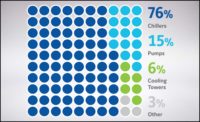A new breed of high-performance gas turbines (GTs), such as the H-class, offer exceptional efficiency and responsiveness. With net efficiencies of more than 60% when run in combined cycle mode, they are becoming the turbine of choice in PowerGen applications. These turbines are helping reduce global CO2 emissions and bridge the gap to meet global energy demands while renewable resources are developed. However, to ensure these levels of performance are maintained, manufacturers of filtration systems also need to up their games to ensure protection of these valuable assets when operating in real-world conditions.
One of the challenges for power plant operators is how to protect turbines from the harsh environmental conditions on-site. Standard tests run in laboratory conditions give some “on paper” indication of how filters will perform, but the reality is often different. Indeed, even with as much lab testing as possible, it’s no substitute for real-world testing. Having test rigs running at or near GTs sites for periods of six months to a year at a time, with continuous monitoring of performance, gives a true indication of how a filter will perform.
Of course, each installation environment has its unique challenges. Some are in hot, dusty regions; some inland; and others are near the coast. Some are in temperate areas, others places where it is cold and wet. To design a filter to handle real-world challenges, therefore, requires testing in all these different climates. This takes time and investment, but is it worth it? Considering the investment made in GT technology, this level of testing is not only worth it but absolutely necessary to ensure ongoing performance and to protect this highly valuable and precisely engineered machinery.
As GTs become increasingly efficient, the effect of contaminates on them means a proportionally larger impact on their output. Dust particles greater than 5 microns can cause erosion, affect turbine reliability, and damage machinery. Finer dust can stick to machine parts and change operating aerodynamics, reducing turbine efficiency and increasing operational costs. Moisture can combine with dust, swelling particles, and blocking filters. If not handled correctly, this can cause sudden pressure rises and result in turbine shutdown.
The hygroscopic nature of salt makes it a particularly difficult contaminate to handle. It can combine with fuel in hotter areas of a turbine and cause Type I and Type II accelerated corrosion with severe impact to the GT. If near the sea (within 12 miles), a filter needs to deal with both dry and sticky salt particles.

Holistic Design
The design of an effective filtration system takes in many factors, including pressure loss, protection from contaminates, and maintenance overheads. It goes beyond media selection and includes other components, such as pulse systems for self-cleaning filters. GT inlet houses will contain multiple filters and a pulse system will typically clean two of these at a time, reversing only a small proportion of the GT inlet airflow. Realistic test results, therefore, require multiple filters to be running.
Having mobile test rigs with multiple filters that can be installed at or near GT sites where real contaminates are present, is the best way to ensure a filter will perform as expected when it is installed. By tracking multiple environmental parameters such as fog, mist and recording details of filtration system performance such as pressure loss, through remote monitoring over extended periods, designers of filtration systems can learn from information that simply cannot be obtained in a laboratory environment. Armed with this valuable data, engineers can better understand the factors that affect performance in different environments and adjust filter designs to optimize their performance.
By way of example, Parker has in-field mobile test rigs in the desert in Riyadh (see Figure 1), coastal desert in Dammam, the cold coastal region in Maine, and, to study behavior in temperate areas, in Missouri. Rigs include two independent wind tunnels, each with up to three stages of filtration including weather hoods with moisture eliminators and coalescers, eight off pulse filter sets with pulse system, and six off static filters. In addition to the filtration stages, it is also possible to include an evaporative cooler section to investigate ambient air cooling, making the rig a four-stage system. Airflow is automatically controlled, and data about system performance captured at a rate of up to once per second. Parameters include airflow, pressure drops, pulse system parameters, test rig temperature, and relative humidity, and other weather-related parameters. Different filters and filter media types can be evaluated, and the effect of other system parameters, such as pulse system settings and design.
The graph in Figure 2 shows an example of the detailed data obtained during an extreme weather event over a five-day period. The filter first experiences almost a day of snow and rain with no change to its operating pressure loss, it then experiences over a day of virtually continuous mist, again with no reaction, which is very promising performance. Only when the mist turns to fog does the pressure loss of the filter start to react and during this unusually long period of heavy fog, does it climb from a steady 1 inwg, peaking at 3.6 inwg before the fog subsides back to mist and the filter’s pressure loss then rapidly recovers. This is invaluable information gained about a filter that has been partially loaded during site operation with site contaminants before experiencing a range of weather conditions that could not be accurately replicated in a lab environment, and so this type of data can only really be obtained from testing in a mobile test rig at site.
An efficient filtration system, designed to optimize performance and pressure drop from inlet to GT exhaust, will reduce operating costs, lower maintenance overheads, and help maintain the exceptional efficiencies associated with modern GT technology.
For greenfield sites, mobile test rigs can also be installed in early stages to facilitate planning and ensure best protection for the new GTs. For existing installations, a mobile test rig can be used to assess whether the GT is sufficiently protected from local contaminates, and, without risking GT reliability or availability but maintaining the validity of the data by running at the same site under the same conditions, it can independently compare the performance of different filtration solutions to establish the best solution for the unique site conditions.
By employing a mobile test rig on-site, operators can see with confidence which filtration options offer the best performance to meet their site needs in terms of efficiency, maintenance, and cost. With complete control of test parameters and comprehensive data monitoring, testing at this level means there is no doubt the filters selected will perform as expected in the real world.
For Parker, the investment in mobile test rigs located in different environmental conditions throughout the world is a vital part of its commitment to assure its filtration solutions perform predictably and reliably when installed. Combined with decades of real-world experience in power generation applications, the information is used to hone the design of filters to provide the level of protection required for the latest, high-efficiency GT technology.
For power plant operators, knowing filters will perform without surprises and give the peace of mind that both machinery and power output levels have the optimum protection for ongoing, smooth plant operation.





